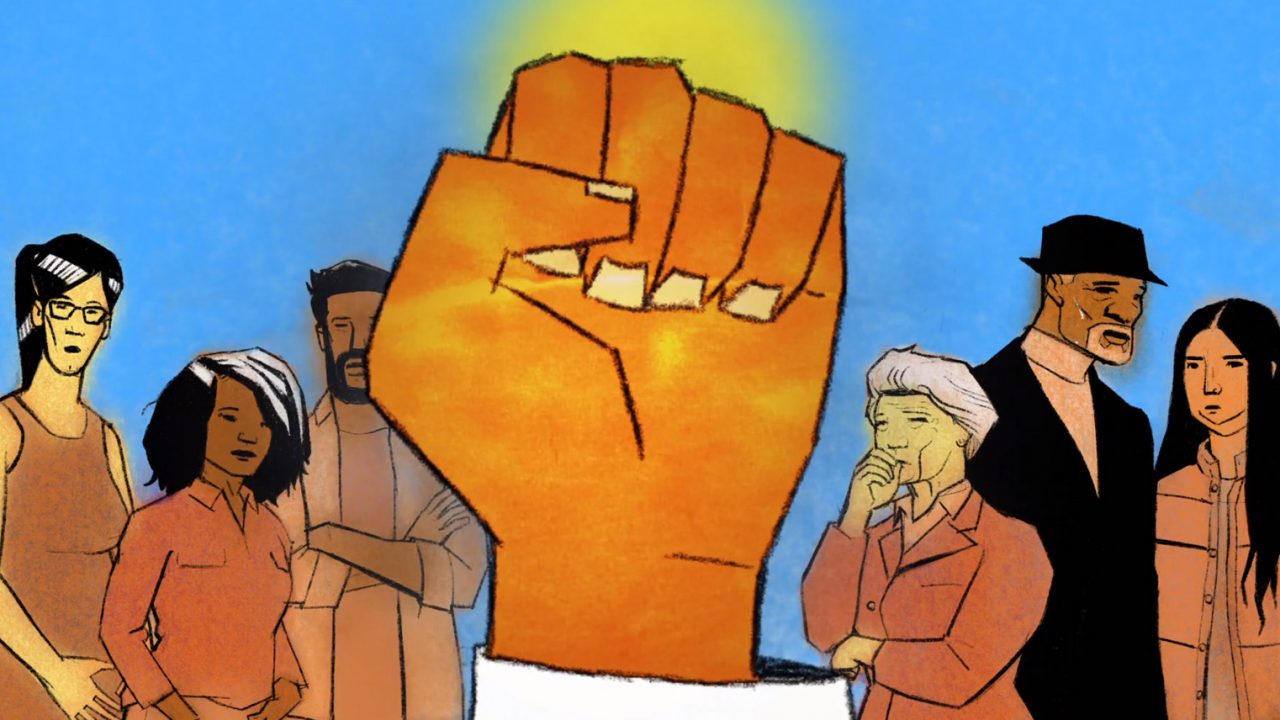
Mini-Lesson for The Big Reset – Governance
Mini-Lesson for The Big Reset – Governance
Mini-Lesson for The Big Reset – Governance
Themes: Citizen Responsibilities, Human Rights, Diversity in Communities, Social Policies and Programs
Recommended Ages: 12-14
The Big Reset – Governance, Ho Che Anderson, provided by the National Film Board of Canada
Keywords/Topics: Community activism, education reform, healing communities, diversity, privilege, defunding the police, equitable actions, intersectionality
Overarching Question: How can we ensure that our communities are governed in a way that is inclusive and equitable to all?
Educational Synopsis: In this three-minute film, community activist Munira Abukar discusses the misconception that we live in a truly equitable society. Students are challenged to consider what changes can be made so that all voices are heard and everyone feels safe and supported.
Activity 1: Education Reform – Discussion, Rank and Order
The Big Reset – Governance, Ho Che Anderson, provided by the National Film Board of Canada
Munira Abukar begins by claiming “the personal is political.” Ask students to come up with two or three situations that would prompt them to protest formally at their school. Highlight that this would go beyond simply complaining and entail taking action to make change. It may even involve risking disciplinary action.
Give students time to write answers on their own. Then, as a class, create a list of causes that merit official protest within a school environment.
Have students rank what the most effective form of action might be to create change within a school or school board. Options could include:
- Setting up a meeting with the administration;
- Using social media;
- Inviting members of the media;
- Staging a walk-out;
- Signing a petition, etc.
Which form of activism would they be most likely to participate in?
Finish with a discussion of whether or not they see inequity in their own school or school system. Do some schools have greater access to resources? Why or why not? How can this be changed? (Note that this may be easier for older students who have attended other schools in the district.)
Summary
The goal here is for students to realize that the “political” isn’t always abstract; it can start directly in your community. In addition, the educational field, where students spend much of their time, is often the subject of debate for political activists: who can attend certain schools, what is taught, which schools get resources, etc.
Activity 2: Healing, Enforcing, and Community Building – Who Gets Funded?
The Big Reset – Governance, Ho Che Anderson, provided by the National Film Board of Canada
In the film, Munira Abukar uses a metaphor of the hand to discuss an entire community working together to create a healing and safe environment. Building on the metaphor of five fingers, have students partner up and discuss what five areas should receive funding in order to ensure safety and security so that everyone feels safe. Students should concentrate on what would work in their own community, where they live. In younger grades, teachers could have students trace their own hand on a piece of paper and then fill out their five choices. Here are some potential options, but students should feel free to add others:
- Addiction counselling and rehabilitation programs
- Anti-poverty organizations
- Community nurses
- Community outreach to various cultural groups
- Implementing universal basic income
- Indigenous community leaders
- Mental health professionals
- Police enforcement
- Police outreach
- Spiritual leaders
Once students have chosen their top five, have them research two statistics or news stories, ideally from their own community again, that would support their choices. This research could support either why one area should get more funding or why another area should receive less funding.
These choices can then be discussed as a class along with the statistics, or they can be put on display.
Summary
Ideally this activity will give all students a chance to express their opinion, even if in a non-verbal manner. In this way, the teacher can aim to give “everyone the microphone” in analyzing how to make their own community safe.
Activity 3: Hearing from All Voices – Mind Map
The Big Reset – Governance, Ho Che Anderson, provided by the National Film Board of Canada
The film ends by saying that it is not enough to earn a seat at a decision-making table. Instead, we need a mind-shift towards creating not only our own table, but our own arena, open to all voices.
In a representative democracy like Canada, it is often the case that some voices are not heard. Have students create a mind map of voices that are not always represented or those who have lesser representation in their local, provincial or national government (teacher’s choice). Students can consider barriers such as age, economic status, gender, language, culture, etc.
Then have students look at one category with lesser representation. What top three actions could be taken by a politician or community group in order to amplify the voice that has been marginalized? Consider digital and physical possibilities.
Summary
Students should come out of this activity realizing that representation matters, and that both community groups and politicians have a role to play in ensuring that all marginalized voices are heard.
Take Action: Making the Personal Political – A Photograph Wall for Positive Community Change
Have students come up with a community-based issue that is important to them personally. This could be any aspect of their community that they think needs change or needs protection. This builds on ideas from Activity 1 but can go well beyond the school arena. Some ideas could include:
- Access to health services
- Access to a living wage and fair working conditions
- Arts programs
- Community-building activities (events, festivals, etc.)
- Environmental action that happened or should happen (park clean-up, safe water, pollution, etc.)
- Equal representation of their culture or gender in governance
- Protection or creation of a community area (sports-related, park, etc.)
- Protection of vulnerable groups (young, elderly)
- Safety in the community
Then have the students either find or take a photograph illustrating why this community-based issue is important. The photograph could be of a landscape or particular area, a person, or an event. The teacher should note that any photographs of people should only be taken with their permission. Students could also potentially find a photograph that already exists online.
Ask students to write a brief paragraph about why they consider this issue to be important for their community. Students can discuss what they feel needs to be done to advance this issue or to create change around it. Finally, students could write about why they chose this particular photograph and why the image stood out to them.
These photographs and their subsequent paragraphs could then be posted on a wall within the school with the relevant community-based issues written across the top. In this way, a conversation may be started about what is important and worth fighting for according to the student community. The personal becomes political.
Carla McIvor currently teaches Social Studies at West Island College in Calgary, Alberta. She has also taught courses ranging from Philosophy to Comparative Government in British Columbia and Ontario. Carla has a B.A. in Political Science from McGill University, a B.Ed. from University of Ottawa and a master’s degree in International Relations from the University of Geneva.
Pour lire cet article en français, cliquez ici.
Discover more Mini-Lessons | Watch educational films on NFB Education | Watch educational playlists on NFB Education | Follow NFB Education on Facebook | Follow NFB Education on Pinterest | Subscribe to the NFB Education Newsletter



